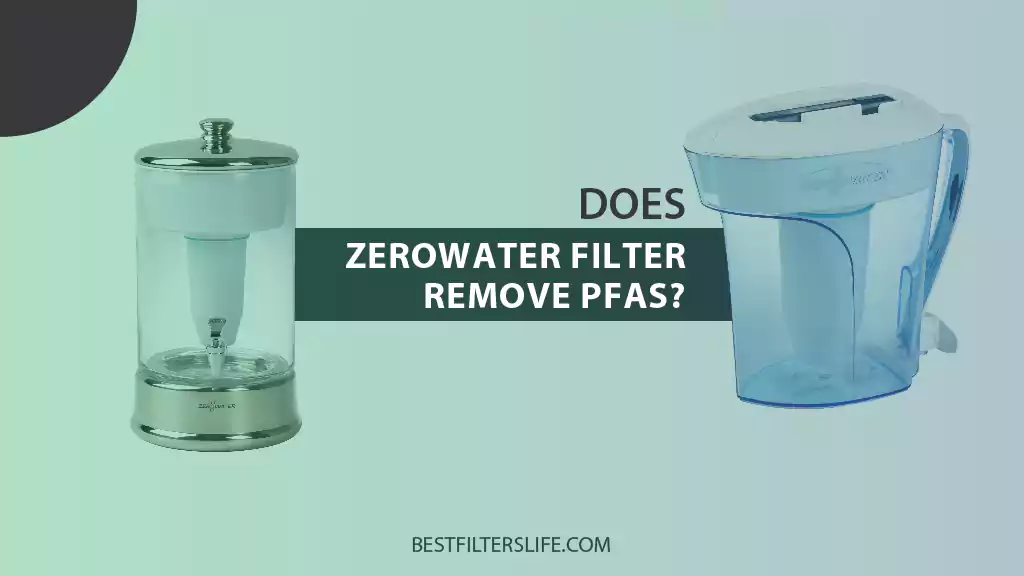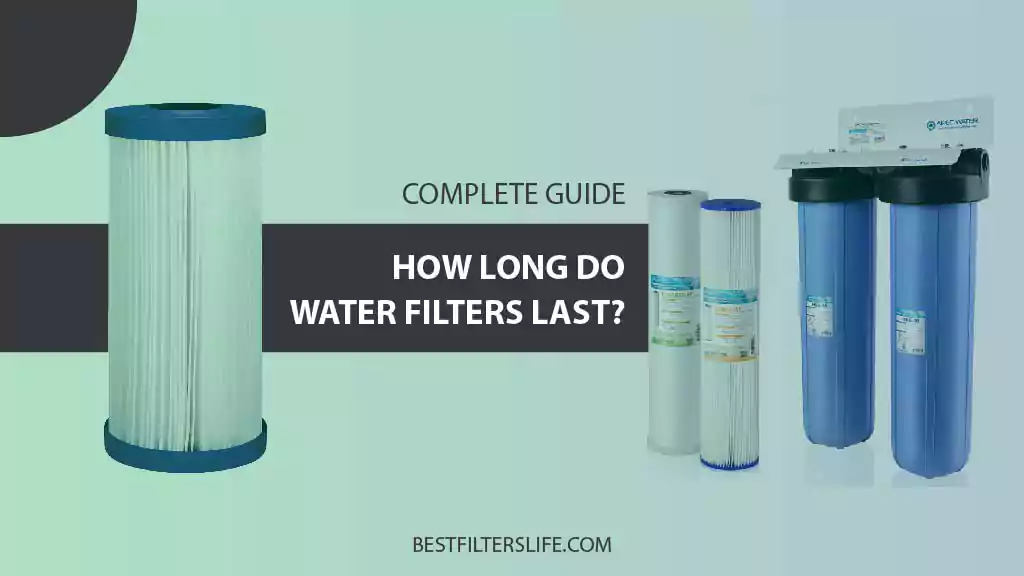There is no denying that PFAS contamination is a massive problem in drinking water. Millions of people are affected by this problem, and finding a solution has become a top priority. PFAS has become a widespread issue, with detectable levels found in 83% of waterways tested across the US. Not only do these toxic substances affect the environment, but they also pose a danger to human health. We must look for solutions to such hazards.
It’s no wonder people are searching for solutions to ensure the safety of their tap water, given such alarming statistics. In such a case, the ZeroWater filtration system claims to remove PFAS from drinking water. Yet the question remains – Does ZeroWater Filter remove PFAS effectively?
In this article, we’ll investigate ZeroWater and see whether it matches its claims. Once you have the facts, you can decide if ZeroWater can solve your PFAS contamination concerns.
Let’s discover what the zerowater filter is all about.
- What is PFAS?
- What Level of PFAS is Safe?
- Does ZeroWater Filter Out PFAS?
- Which Zerowater Filter Remove PFAS?
- Explanation of the process by which ZeroWater filters remove PFAS from drinking water
- What Are the Dangers of PFAS Exposure?
- Conclusions on the effectiveness of ZeroWater filters in removing PFAS and considerations for selecting a filtration system to remove PFAS.
What is PFAS?
Per- and poly-fluoroalkyl substances (PFAS) and perfluorooctane sulfonic acid (PFOS) are synthetic chemicals that have been widely used since the 1950s. They are known for their non-stick, waterproof, and heat-resistant properties. These toxins can also be found in various industrial and consumer products, such as food packaging, textiles, furniture, and fire-fighting foams.
A recognition of the health and environmental risks posed by PFAS began in the 1990s, leading to efforts to restrict or phase them out. Due to their persistence in the environment and potential health hazards, PFAS remains a concern despite these efforts.
Now we will discuss shortly the types of PFAS.
Types of PFAS in drinking water
Many different types of PFAS (Per- and poly-fluoroalkyl substances) have been identified, including.
- PFOS (perfluorooctane sulfonic acid)
- PFOA (Perfluorooctanoic acid)
- GenX (a PFAS used as a replacement for PFOA)
Although some have been reported as contaminants in drinking water, the above three are the most common concerns with water contamination.
- PFHxS (perfluorohexane sulfonic acid)
- PFNA (Perfluorononanoic acid)
- PFDA (Perfluorodecanoic acid)
- PFUnA (Perfluoroundecanoic acid)
- PFDoA (Perfluorododecanoic acid)
- PFTeDA (Perfluorotridecanoic acid)
These are only a few examples of PFAS compounds. Since some PFAS are more persistent and toxic than others, the health risks may vary.
How Are PFAS Exposed in Your Drinking Water?
PFAS, PFOA, and PFOS can enter the drinking water supply through various sources. Some common ways include
1. Leaching from PFAS-containing products:
Food packaging and non-stick cookware can leach PFAS into the environment and drinking water.
2. Discharge from industrial facilities:
Industrial facilities that use PFAS-containing chemicals can discharge them into waterways, contaminating drinking water.
3. Contamination from fire-fighting foam:
Training foams and firefighting activities can contain PFAS, which can contaminate soil and groundwater near military bases and airports.
4. Runoff from landfills:
Landfills can also contribute to PFAS contamination of drinking water through runoff and leaching into groundwater.
PFAS and PFOS should be monitored and tested in drinking water to ensure they are safe to drink and removed if necessary.
What Level of PFAS is Safe?
The safe level of PFAS (per and poly-fluoroalkyl substances) in drinking water is still a subject of scientific debate and ongoing research. There is currently no federal standard for PFAS in drinking water. However, some states have set their standards based on health advisory levels.
The Environmental Protection Agency (EPA) has set Lifetime Health Advisory Levels for two specific PFAS chemicals (PFOS and PFOA) at parts in 70 trillion (ppt), which is legally binding, not the standard.
New research indicates that specific adverse health effects can occur when PFOA or PFOS levels in water are near zero and below the EPA’s current detection limits. Generally, the lower the levels of PFOA and PFOS, the lower the risk to public health.
In the meantime, we recommend you reduce your exposure to PFAS and regularly test your drinking water for PFAS.
Does ZeroWater Filter Out PFAS?
A brand of water filtration system called ZeroWater claims to remove PFAS (per and poly-fluoroalkyl substances) from drinking water. The ZeroWater filters remove positively charged ions, including PFAS, from the water using ion exchange resin.
ZeroWater filters’ effectiveness in removing PFAS has not been extensively studied, but some laboratory tests have demonstrated they are effective. A ZeroWater filter’s ability to remove PFAS will depend on several factors, including its type and concentration of PFAS in the water, age, and overall performance.
For any water filtration system to work effectively and remove contaminants, including PFAS, it is crucial to replace the filter cartridge regularly.
To conclude, ZeroWater filters can significantly reduce PFAS levels in drinking water. For optimal performance, it is essential to understand their limitations and replace the filter cartridge regularly.
| Related Articles |
|---|
| Best under-sink water filter to remove PFAS Best water filter pitchers to remove fluoride |
Which Zerowater Filter Remove PFAS?
Different ZeroWater filters may remove PFAS differently. Drinking water should still be protected against PFAS through the use of any ion exchange resin-based brand filter.
The table below summarises the estimated PFAS removal rates of some popular ZeroWater filters. NSF and WQA conduct tests and certifications for zerowater filters.
| ZeroWater Filters | External Certifications | PFAS Removal Rate | Other Contaminants Removed |
|---|---|---|---|
| 40 Cup Glass 5-stage Water Filtration Dispenser | NSF/ANSI standards 42 and 53 Certified | High | 99.6% of Total Dissolved Solids (TDS) |
| 30 Cup ZeroWater 5-stage Filtration Dispenser | NSF Certified | High | 99.6% of Total Dissolved Solids (TDS) |
| ZeroWater 20 Cup 5-stage Water Filter Dispenser | NSF Certified | High | 99.6% of Total Dissolved Solids (TDS), |
| 12 Cup ZeroWater 5-stage Water Filtration Pitcher | NSF/ANSI standards 42 and 53 Certified | High | 99.6% of Total Dissolved Solids (TDS) |
| 10 cup ZeroWater 5-stage Water Filtration pitcher | NSF/ANSI standards 42 and 53 Certified | High | 99.6% of Total Dissolved Solids (TDS) |
| 7 Cup ZeroWater 5-stage Water Filtration Pitcher | NSF/ANSI standards 42 and 53 Certified | High | 99.6% of Total Dissolved Solids (TDS) |
| ZeroWater’s 6 Cup 5-stage Water Filter Pitcher | NSF/ANSI standards 42 and 53 Certified | High | 99.6% of Total Dissolved Solids (TDS) |
| ZeroWater Faucet Mount filtration system ZFM-400CR | WQA Certified | High | 98% of Total Dissolved Solids (TDS) and other contaminants |
| ExtremeLife™ Faucet Mount filtration system | WQA Certified | High | 98% of Total Dissolved Solids (TDS) and other contaminants |
Note: These removal rates may vary according to specific conditions and contaminants in the water.
| Related Readings: |
|---|
| Check NSF Certification for zerowater filter What Is The Best Type Of Whole House Water Filter |
Explanation of the process by which ZeroWater filters remove PFAS from drinking water
In ZeroWater filters, PFAS (Per- and poly-fluoroalkyl substances) are removed through a multi-stage filtration process. Typically, the process involves the following steps:
- Ion Exchange Resin:
It is the ion exchange resin that removes the positively charged ions from the water at the first filtering stage.
- Activated Carbon:
Second-stage filtration includes an activated carbon block, which removes chlorine and volatile organic compounds (VOCs).
- Dual-Layer Filtration:
In the third stage, a proprietary blend of resins is used to remove PFAS and other contaminants from the water. This stage is designed specifically to target and remove PFAS from water.
- Non-Woven Membrane:
During the fourth filtration stage, a nonwoven membrane filters out particles and contaminants too small for the other stages.
- Polishing Filter:
Final filtration involves polishing the water to remove any remaining impurities and improve its taste.
ZeroWater filters remove PFAS from drinking water through a multi-stage filtration process. Consider your zerowater filter needs before buying or choosing one.
What Are the Dangers of PFAS Exposure?
These synthetic chemicals have been widely used since the 1950s because of their non-stick, waterproof, and heat-resistant properties. PFAS exposure has been linked to several health risks, including
- Cancer:
Cancers such as liver and testicular cancer have been linked to PFAS exposure in some studies.
- Immune system suppression:
There is evidence that PFAS weakens the immune system and increases infection risk.
- Liver damage:
Long-term exposure to PFAS can damage the liver and affect its function.
- Hormonal changes:
PFAS have been shown to disrupt thyroid hormones.
- Child and infant development and low birth weight:
Children and infants exposed to PFAS during pregnancy have been linked to low birth weight and developmental effects.
- Increased cholesterol levels:
Heart disease risk can be increased by PFAS exposure.
PFAS exposure may pose specific health risks depending on the type, dose, duration, and individual factors such as age, gender, and health status. There is ongoing research on the health effects of PFAS exposure.
Conclusions on the effectiveness of ZeroWater filters in removing PFAS and considerations for selecting a filtration system to remove PFAS.
In summary, ZeroWater filters effectively remove PFAS from drinking water. ZeroWater filters reduce PFAS levels in water by attracting and binding them using ion exchange resin.
However, not all ZeroWater filters are alike in their ability to remove PFAS. Factors such as the age of the filter, the flow rate of water, and the presence of other contaminants can affect their effectiveness. However, some of the zerowater filters listed above have been tested by NSF and WQA and are effective against PFAS.
FREQUENTLY ASKED QUESTIONS
Some other questions and answers for our readers might be helpful for reading.
Does Zero Water Filter Remove Pharmaceuticals?
ZeroWater filters are designed to remove many contaminants, including some pharmaceuticals.
Does Zero Water Filter Remove Microplastics?
No, ZeroWater filters do not precisely remove microplastics from water. Hence, they are made of PVC, which does not include leaching microplastic into filtered water.
Does Zero Water Filter Remove Fluoride?
Yes, ZeroWater filters are designed to reduce fluoride levels in drinking water.
Does ZeroWater Remove Minerals?
ZeroWater filters remove dissolved solids, including minerals, from drinking water.
Does the zerowater filter remove fluoride?
Yes, ZeroWater filters are designed to reduce fluoride levels in drinking water.





